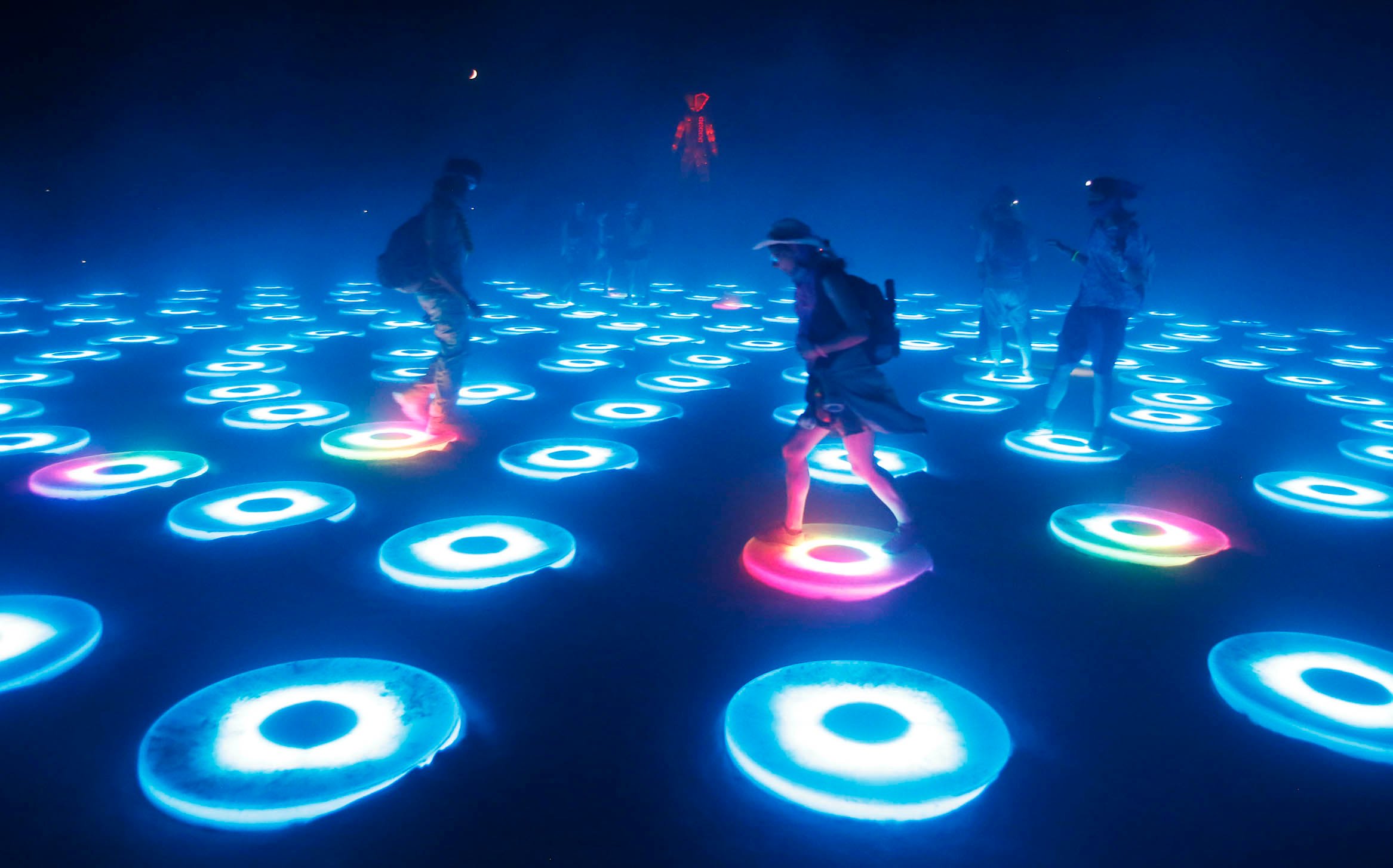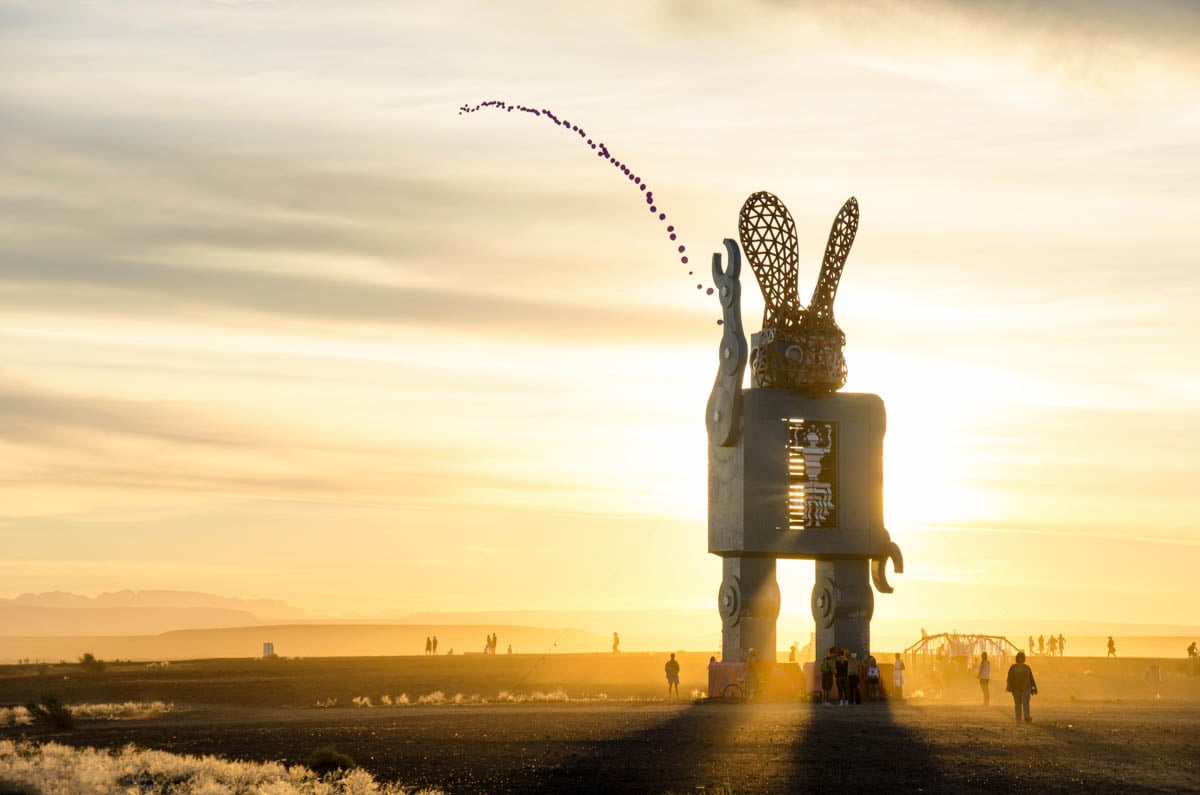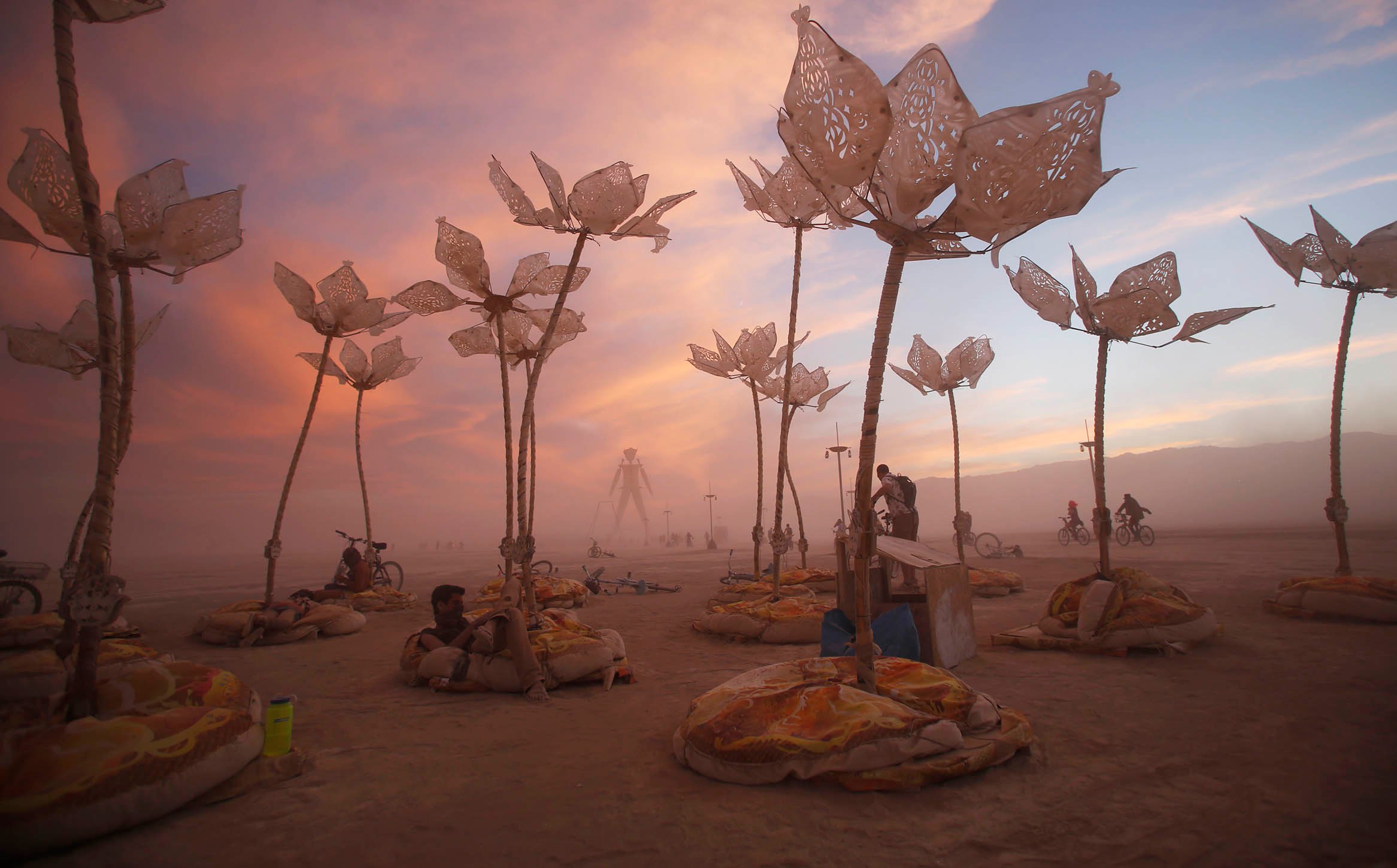The art installation 'Embrace' is seen lit up at night at the 2014 Burning Man festival in the Nevada desert.
On paper the Burning Man festival in Nevada’s Black Rock Desert is like AfrikaBurn, its regional offshoot in the Karoo: a circular layout with camps enclosing a big, open space in a desert setting with artworks, run on a gifting economy.
Both are spectacularly surreal places that defy description, but in scale and in charm AfrikaBurn is considered to be what Burning Man was 20 years ago.
Traversing and navigating the several-kilometre-wide area that is Black Rock City is best tackled by bicycle — it can take hours to walk around and only see a small part of it — or by catching a ride on art cars, which range in scale from life-sized pandas to a supersized yacht.
The artworks laid out on the cracked floor of the ancient desert lake bed known as “the playa” are truly astounding. This year there was the Super Pool, a field of LED lily pads that lit up as you stepped on them; the 21m-high Embrace, a wooden sculpture of an interlocked couple, which burned at sunrise one morning; Pulse and Bloom, huge lotus flowers that opened up when touched, and the deeply meditative and intricately carved Temple of Grace, where people left messages to loved ones who had died, which was burned in a silent ceremony.
These installations make up the world’s most impressive outdoor art gallery.

At the centre of it all is the eponymous man, which this year was a huge wooden effigy that went up in a powerful blaze on the second-last night.
In the “suburbs”, rows and rows of concentric streets are lined with camps and villages that offer food, bars and showers, a farmers’ market, skate park and roller disco, workshops on qi gong and meditation, yoga, ballet classes, pillow fights, English afternoon tea parties and karaoke nights as well as a day of TEDx talks.
At night there are hundreds of dance floors, some with sound systems that rival those of super-clubs — and the big-name DJs and acts. This year they included Major Lazer, Skrillex and Thievery Corporation, who often play sets unannounced.
And then, of course, there are the people — the “burners” who make this event what it is. There’s no small talk or handshakes at Burning Man: it’s all hugs and conversations about cognitive science, art, travel, the meaning of life and Stanley Kubrick films.
Burning Man surpasses all ideas of what you think a festival can be. In fact, it’s not a festival at all. Black Rock City is a fully functioning temporary metropolis. It’s become the fifth-largest city in Nevada during its week of existence and you can find its street names on Google Maps. It has an airport, two radio stations, a newspaper that gets printed several times during the week, post offices, plazas that function as town squares — and a committed, self-policing group of citizens who, for the most part, subscribe to a culture that’s been developing organically since 1986.
It’s easy to see why people like Aviv Weil, a 35-year-old from Johannesburg who works as an independent creative consultant in the advertising industry, travelled all the way from South Africa to the United States, along with other participants from around the world, for just one week.
Weil, who’s visited Black Rock City three times, says: “Burning Man represents humanity at its best. It’s proof that, given the chance, far away from the pressures of society and status, people are inherently kind and generous. I think we could always use a reminder of that — for me, it’s Burning Man.”

Cape Town-based Brian Little (38), the managing director of Seed Experiences, the events company behind the Western Cape’s Rocking the Daisies music festival, agrees that the long trip to the Black Rock Desert is justified: “The sheer scale, history, pride and sense of real community you feel at Burning Man is simply astounding. It’s not something you will experience at AfrikaBurn — yet.”
Although AfrikaBurn, now only in its eighth year, is indeed much less developed than Black Rock City, it does have a charm all of its own. Since its first year, when it had just under 1?000 participants, it’s grown rapidly to become the largest of more than 65 official Burning Man regional events globally, and has had significant year-on-year growth in international participants, including a large number from the US.
AfrikaBurn’s principles mirror those of Burning Man, which has been running for nearly three decades and now attracts 65?000 people. The relationship between the two is strong: Burning Man organisers have volunteered at the South African event, and this year several members of AfrikaBurn’s production team volunteered at Burning Man. There are also artworks and theme camps that travel between the two events, and many devoted South African “burners” make the annual journey to Nevada.
It’s still got what Matt Buonaguidi, a 50-year-old retired California state park ranger who attended AfrikaBurn for the first time this year, calls a “small-town feel” that lends itself to more intimacy. And it also has a distinctly African flavour.
Mike Suss, a co-founder of AfrikaBurn who has attended the US event several times, says AfrikaBurn is “more DIY and rough around the edges” — with more tents and homemade structures than the motor homes and sophisticated camps with catering options in the US.
Steven Raspa, Burning Man’s community events organiser and regional network committee member, says a large part of AfrikaBurn’s success lies in the fact that “right from the start organisers emphasised the importance of art and participation in a decommodified environment. They also started with a strong base of local artists and free thinkers, as we did. By sending a strong message and setting a strong intention, they created the right conditions for something very special to bloom.”
Leaving no trace is just one of AfrikaBurn’s 11 guiding principles, which include communal effort, participation, gifting, decommodification, radical inclusion, radical self-reliance and radical self-expression.

Decommodification and radical self-reliance are taken seriously. Other than ice, there’s nothing for sale at the event and no branding is allowed (even the logos on the rented portable loos are covered up). People need to bring everything they need to survive a week in the harsh climate of the Karoo, from drinking water and shelter to food.
As opposed to what many who haven’t been to the event think, there isn’t a bartering system: each participant is urged to gift without the expectation of anything in return. What this results in is the most inspiring display of generosity.
People give away hugs, hot dogs and cold beers, ice lollies on hot afternoons, dress-up costumes and thoughtful home-made presents. Even the most confirmed cynic would find it hard not to be moved by this glimmer of what social utopia could look like — albeit in a uniquely microcosmic context.
Raspa also points out the importance of the similarities between the Tankwa Karoo and the Black Rock Desert: “Both are extreme and magical places that inspire a sense of awe. They are places that are as brutal and humbling as they are beautiful. Going to Burning Man and AfrikaBurn involves a similarly challenging pilgrimage that leads people out of their usual social context and into another that is equalising, versus one that is based upon social status and commercial transactions.”
One thing’s certain — the appeal that these transcontinental arts events have is increasingly alluring to people across demographics. The events have “developed out of a need that’s lacking in an emotionally bankrupt world that is geared towards the transaction and consumerism, and not engagement”, says AfrikaBurn co-founder Monique Schiess. “We’ve created environments where people’s creative sides are being woken up.”
AfrikaBurn and Burning Man don’t purport to be desert versions of a societal Shangri-La — a point that many critics seem to forget. Instead they offer the chance to step outside of normal life (or, in burner parlance — the “default world”) and have the kind of profoundly transformative experiences that are undoubtedly worth travelling halfway around the world for.
AfrikaBurn takes place from April 27 to May 3 2015. Visit afrikaburn.com. Burning Man takes place from August 29 to September 5 2015. Visit burningman.com